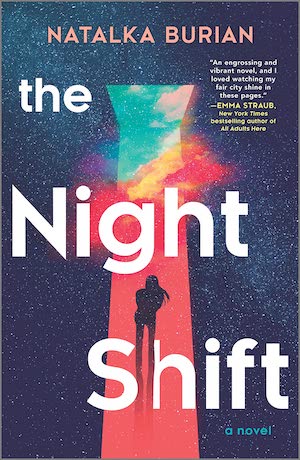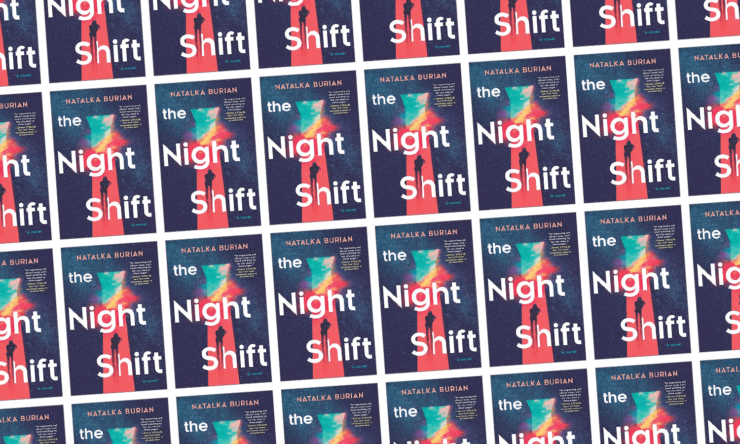New York is a city in which the fabric of space-time seems particularly flexible. It’s not just how the subway, rushing inconsistently at all hours, feels like it could open onto any moment in the past. (It is a time travel portal in Russian Doll and Casey McQuiston’s One Last Stop). It’s not just the way the city’s history is right there, all the time, in the names of places, the name of the island of Manhattan itself, the gaping space in the downtown skyline that some of us can never not see.
It’s the way the city is layered with the places it used to be. Things can change so fast that if you live in a neighborhood for more than a few years, you don’t just see a present-day bodega, burrito place, inevitable Starbucks; you see all the places those storefronts used to be, the bars long closed, the coffee shops transformed. “But that was New York,” Emma Straub writes in This Time Tomorrow, “watching every place you’d kissed or cried, every place you loved, turn into something else.”
Natalka Burian’s The Night Shift is set in New York City in the early 2000s (a narrative act of time travel in itself). Jean Smith just quit her job; her beloved boss, famed psychotherapist Myra Goldstein, got a little too friendly and curious about Jean’s past, which Jean doesn’t talk about. She throws herself into not just one new job but two: bartending at Red and Gold in the evenings, and working at a bakery following her bartending shift. The hours are long and late and the distance between the two businesses is just a little too far for convenience.
That’s where the shortcuts come in.
Jean learns about the shortcuts from her coworker Iggy, an enthusiastic musician who leads her, late one night, through a door in a diner. When they come out, they’re in a bar directly across the street from Jean’s second job. This is just one of the space-time tunnels through New York, which hide behind nondescript doors in bars, theaters, stores… just about anywhere a tired service-industry employee might need them. What Iggy fails to tell Jean about the shortcuts is that they’re one-way: You go in one door and come out the other, never in the other direction. When she goes the wrong way, she’s not at all clear on what she sees, but to a reader it’s obvious: The strange outfits are a clear marker that she’s in the past.
Buy the Book


The Night Shift
Jean makes it back, but before long, Iggy vanishes, and it seems like he might be stuck in a shortcut. Already pulled reluctantly into Iggy’s social circle, Jean is drawn further into the mystery of his disappearance; she and his friend Claire scour the shortcuts in search of him. What they uncover, gradually, is much larger than any of them.
The mystery that Burian builds gradually expands outward from Jean’s little world, making her life bigger with every huge or intimate revelation. An orphan, Jean has a heavy past, and one that Burian uses to explain Jean’s aversion to getting close to people. It’s a tricky line to walk, folding a character-driven trauma narrative into a speculative story about bartenders and bakers in lower Manhattan, and sometimes Burian’s hand is a little heavy. But when Jean’s at work at the bar, Burian’s prose zips along. She knows of what she writes: the author is the co-owner of two bars, and she charts the rhythms and cycles of her fictional establishment’s evenings with a clarity born of long familiarity.
Her New York is a little harder to get a handle on, in part because while the book is set in a particular moment in time (post-9/11 and the smoking ban, pre-social media), Burian avoids naming many of her locations. Sometimes there’s a delightful bit of specificity (a band plays that’s got members of Jonathan Fire*Eater), but often, I wanted to know which dives and diners the characters were in. I kept pausing to ask myself: Is this Bendix? Should I stop thinking of the (fictional) Red and Gold as the (actual) Blue and Gold crossed with Max Fish? Is this nearby venue Piano’s? Or Mercury Lounge, maybe?
Everyone has their own New York, even people who live in the same apartment building. No one’s combination of favorite coffee shop, bar, bodega, laundromat, sandwich joint, diner, pierogi place is the same. We all run on our own parallel planes, and mine clearly has some—maybe too much!—overlap with Burian’s. Not naming the places might be intended to make the vibe more universal, to let anyone layer their own NYC over this one. But it files off some of the texture and richness that makes a story stick in your heart and mind. I loved wandering my old streets with Jean and Claire. I just wanted to know which streets they were, so that the story might set its feet more firmly in that grubby, street-level New York reality.
But when the story veers off that reality and into the world of the shortcuts, it feels somehow all the more New York. Of course there are magic passageways between these places. Of course a bunch of enterprising twentysomethings would use them to get to work or bars more quickly. There’s something deeply satisfying about a speculative element that fits its setting as well as this one does. It makes perfect sense, the same way that it made perfect sense, in Russian Doll, that the city might kill you at every turn in order to help you work some shit out.
Jean really needs to work some shit out. As her search for Iggy expands, raising questions about the origin of the shortcuts themselves, it becomes clear that understanding the shortcuts is directly tied to something else Jean needs to do: come to terms with the loss and guilt that defines her and makes her life emotionally and physically painful. If sometimes the connections between Jean, her boss, and her friends are a little too convenient, the very real pain she carries around is heavy and honest, and Burian does excellent work rooting it in her body, in the way she walks and carries herself and reacts to stress or relief.
Burian’s characters move through the city in a way that rings deeply true, making connections in some places, running away from others, struggling with the things so many other people take for granted (like finding a car to borrow) while barely noticing half the places and people they walk past every day. The shortcuts are magic, but they’re the kind of magic you find in the city: Something that isn’t just yours, but feels like it is. Jean finds the shortcuts, but she also finds friends, including Alan, an older musician who offers her a piece of true New York wisdom: “This city is a great place to be left alone.”
It’s also a great place to be when you’re ready to stop being left alone. And Jean will get there, once she gets through a plot that shifts gears dramatically toward the end of the book, building considerable momentum toward an ending that manages to feel surprising and like it’s the only way things could have worked out. The revelations that she and her new friends uncover loop in one friend’s wealthy family, some unusual pharmaceuticals, and just the person Jean was running from: Dr. Goldstein, who gradually grows from a memory Jean would rather avoid into a central character in a complicated knot of past and present.
But when you can walk through a doorway into history, the present doesn’t have to stay the way it is. Burian understands so well the connections that get made after midnight, in your twenties, when the city sometimes feels like it sparkles just for you. The Night Shift is a lovely reminder that New York isn’t just a great place to be alone; it’s also a great place to learn how to find family, and how to remake your life when you need to.
The Night Shift is published by Park Row.
Molly Templeton lives and writes in Oregon, and spends as much time as possible in the woods. Sometimes she talks about books on Twitter.










